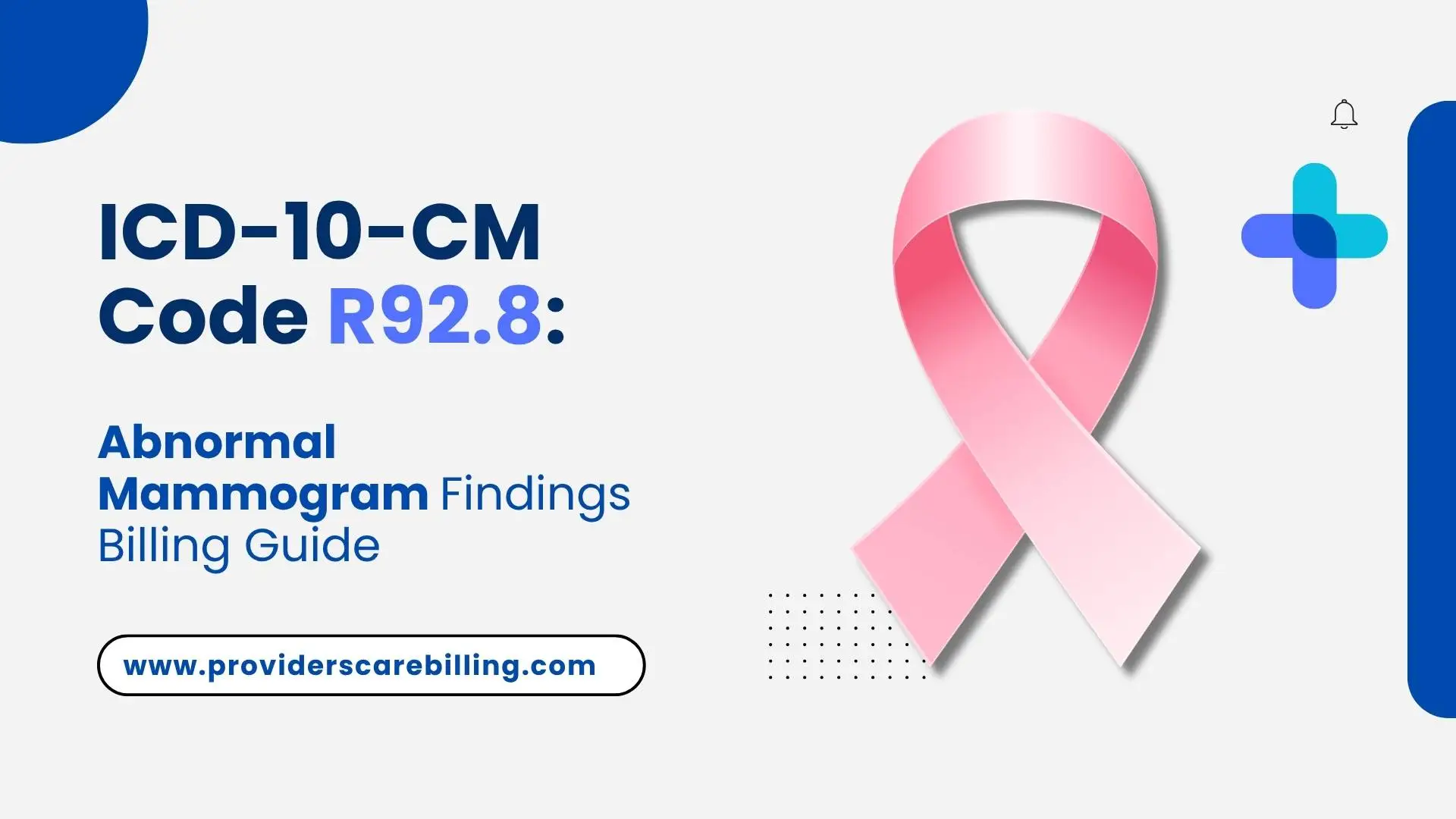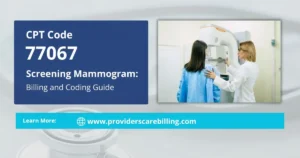“My Mammogram came back abnormal, and I did not know what code to use…”
The patient, who was 45 years old, came in for a screening mammogram on the left breast. There was a suspicious finding detected by the radiologist; nothing definite was detected.
Charging the claim? That became a nightmare of denationalizations.
There are many misuses of coding by many practices in the abnormal mammograms. Learning of CPT Code R91.1, which applies to abnormal and inconclusive breast imaging, and other correct ICD-10 codes, such as R92.1 and R92.8, plays a significant role in being accorded accurate billing and revenue management.
What Is an Abnormal Mammogram ICD‑10 Code?
Every single component of healthcare processes, such as getting paid, staying compliant with regulations, and many others, depends on correct medical coding. As it relates to imaging services like mammograms, precise coding is important due to its role in helping avert breast cancer by enabling early detection.
According to the International Classification of Diseases, 10th Revision Clinical Modification, breast imaging results are classified as follows: aberrant and inconclusive findings may require additional investigation.
R92.2 – Inconclusive mammogram
R92.3 – Mammogram denoting benign microcalcification
R92.8 – Other specified abnormal findings on diagnostic imaging of breast
N63 – Unspecified lump in breast
C50.9 – Malignant neoplasm of breast, unspecified
Why Accurate Breast Imaging ICD-10 Coding Matters for Revenue Cycle Management
- Demonstrating Mastery
While imaging abnormalities are flagged by radiologists, it is the providers and coders who finalize the codes using ICD-10. There is an issue with interpreting R92.8 instead of R92.2, as there will be stalled claims, a decline in revenue cycle management services, and an increase in audit risk.
- Building Influence
An expert at Medical Coding Services quoted official documents stating how “Per ICD-10-CM guidelines, use R92.2 when the mammogram is inconclusive-not—not suggesting any chance of malignancy-and use R92.3 only for benign microcalcifications.”
Payors and patients trust you more if documented references, such as the ICD-10-CM code, are provided rather than uncertainties that are unexplainable..
- Fostering Confidence
Patients get follow-up appointments on time without worrying about delays due to do with billing, due to precise coding with no errors. Retention is increased along with a stronger reputation when medical billing services are used because documentation is complete.
ICD-10-CM diagnosis:
Other abnormal and inconclusive diagnoses on diagnostic imaging of the breast
| Finding | ICD 10 Codes | Description |
| Inconclusive mammogram | R92.2 | Requires further imaging (additional views/ULTRASOUND) |
| Benign microcalcifications | R92.3 | Specific radiologic finding, believed benign |
| Other abnormal mammogram findings | R92.8 | Asymmetry, masses, and architectural distortions |
| Palpable lump identified | N63 | Physical findings observed during exam: mammographic density noted. |
| Suspicion of malignancy after imaging | C50.9 | Confirmed or suspected breast cancer |
Which screening for breast cancer ICD codes are billable?
A mammogram is a type of breast X-ray that looks for any possible abnormalities by scanning and examining the breast. Screening begins at age 40, but may be performed earlier for those with a family history of breast cancer.
It is important to note the difference between these two types of services from a coding perspective:
Screening Mammograms: Conducted on women who have no current signs or symptoms of breast disease but may have inconclusive findings on diagnostic imaging.
Diagnostic Mammograms: These are done when patients come with breast lumps, pain, nipple discharge, or even abnormal results from a previous screening encounter for screening.
As far as medical coding services go, it is very important to understand that documentation supports how the appropriate ICD-10 code will be determined. Thus, all documentation must always support intent.
Medical Billing Scenario: R92.2 vs. R92.8 in Breast Imaging Claims
Introducing Dr. Patel, an OB-GYN based in New Jersey, who just had an abnormal screening:
Report of the mammogram: findings included calcification and other indicators of potential issues. Asymmetry focal, 6 o’clock right breast.
First code: R92.8
Claim negated: The insurer requested further details regarding the abnormal and inconclusive findings noted in the report.
Referral: diagnostic code, repeat mammogram
New records: Inconclusive mammogram—R92.2; triggered the subsequent imaging
Result: The presence of calcification was noted in the mammographic report. The claim was accepted, a patient received an ultrasound, and later, there was a malignant cyst.
The described scenario points to the growing importance of excellent clinical documentation and proper use of Abnormal Mammogram ICD 10 and remote credentialing. Once your medical billing company has got it right, you win, your bottom line wins, and best of all, so does the patient.
Let Providers Care Billing LLC assist you if claim denials, abnormal mammogram ICD-10 related billing mistakes, or revenue cycle inefficiencies are causing frustration. 👉 Get a Free Coding Audit, and we’ll analyze a month’s worth of mammogram claims for R92.x miscoding errors.
📞 Call Now: 888-495-3786
📧 Email: Info@providerscarebilling.com
✅ Schedule your Free Consultation with our medical billing specialists to unlock the value of your claims today!
Who is to Code and Bill This?
Abnormal mammography management occurs at the level of radiology, breast centers, primary care, and OB/GYN. Practices may require the assistance of a Medical Billing Company in understanding and correctly using CPT/ICD-10 pairing and modifier-based reimbursement compliance and the 2025 ICD-10-CM.
In some complex cases where abnormal imaging findings coincide with respiratory issues, it’s important to also code accurately for conditions like Acute Respiratory Failure with Hypoxia (ICD-10 Code J96.01) to support thorough documentation and billing.
Conclusion
Correct coding of abnormal mammograms is crucial to productivity. Using the correct ICD–10 codes R92.1, R92.2, or R92.8. The same goes for Diagnostic Mammography CPT Codes 77065/77066, which increase clean claim rates as well as reimbursement and compliance. Errors in coding may disrupt the revenue cycle, but more importantly, they expose you to intensive audits and compliance risks related to the ICD-10-CM diagnosis code.
Ensuring client success motivates Providers Care Billing LLC as a dependable Medical Billing Company to offer skilled and detailed revenue cycle management, credentialing, and medical coding services, which guarantees that all claims are presented with pertinent papers for the best return on capital.
Frequently Asked Questions
- Can R92.8 be considered a primary diagnosis?
Yes, as long as a certain imaging finding has not been certified, and another code is more exact.
- Is follow-up imaging required in R92.8?
Yes, in most cases, it must be stated what further imaging is going to be followed or possibly a biopsy.
- Do I put in symptom codes (such as lump)?
Yes, in order to facilitate a medical necessity, particularly E/M visits.
- Can a diagnostic mammography and screening be billed on the same day?
Yes, under modifier GG on diagnostic service. There should be documentation as to why both are warranted.




